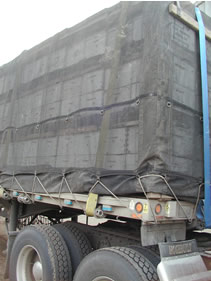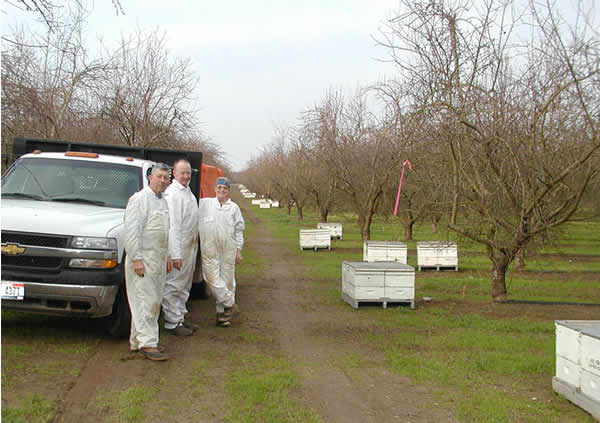


   |
|
Bees are transported on flatbed tractor trailers and trucking bees is a very specialized business. Bees must be handled (loaded or unloaded) when they are not flying; which means at night or in cold weather or both. There is no practical way to "lock" bees in their hive for transportation, although if there were, moving bees would be a lot easier. Our bees are loaded out of storage in Idaho at sundown, even though usually this time of year it's cold enough to load them during the day. The load is netted and the truck sits for the better part of the night and the trip begins the next morning. In order to minimize the bee loss during daylight hours, the truck must keep rolling - bees don't fly on windy days, especially when it's blowing 50 to 60 mph! Except for unavoidable stops, a good driver will keep the truck rolling from sunup to sundown. Depending on the temperature, should the truck stop for more than a few minutes during the day, the bees would start flying. Even though only a few would find their way out of the net, all those attempting to fly are lost; as they are not able to find and return to their hives under these conditions. Once out of the hive in the daylight, they will continue to fly against the net until they drop to the truck bed and die. Losses are inevitable, but as a percentage of the bees in any one hive it is small. The trip is planned to arrive at the unloading point right at sun down which is what's happening on above. Notice there is practically no flight activity as this is around 5:30 PM and in the shade of the adjacent building. It takes about an hour with two fork lifts to transfer the bees from the tractor trailer to smaller trucks for the trip into the orchard for placement - all of which is done at night. The bees awake the next morning and begin orienting themselves to the new location. After being in storage for two months and being trucked, they are glad to get outside and fly - free at last! Another concern anytime bees are trucked is simply keeping all the parts and pieces of the bee hive together and on the truck. Bee hives are nothing more than a stack of boxes and if you've ever stacked boxes 6 high in a pickup truck and driven somewhere, you know the problem. The net helps in this regard, as it is the last line of defense for anything coming off the truck, but the large cross and lengthwise straps do the major part of the job keeping the load together. A break down for the truck could be disastrous for the bees - whole loads of bees can be lost depending on the temperature and the length of time the truck sits in daylight hours. Any type of accident on the road is equally perilous. If there's trouble on the road, there's one thing you can count on - finding help will not be easy - who wants to get stung! |
 |